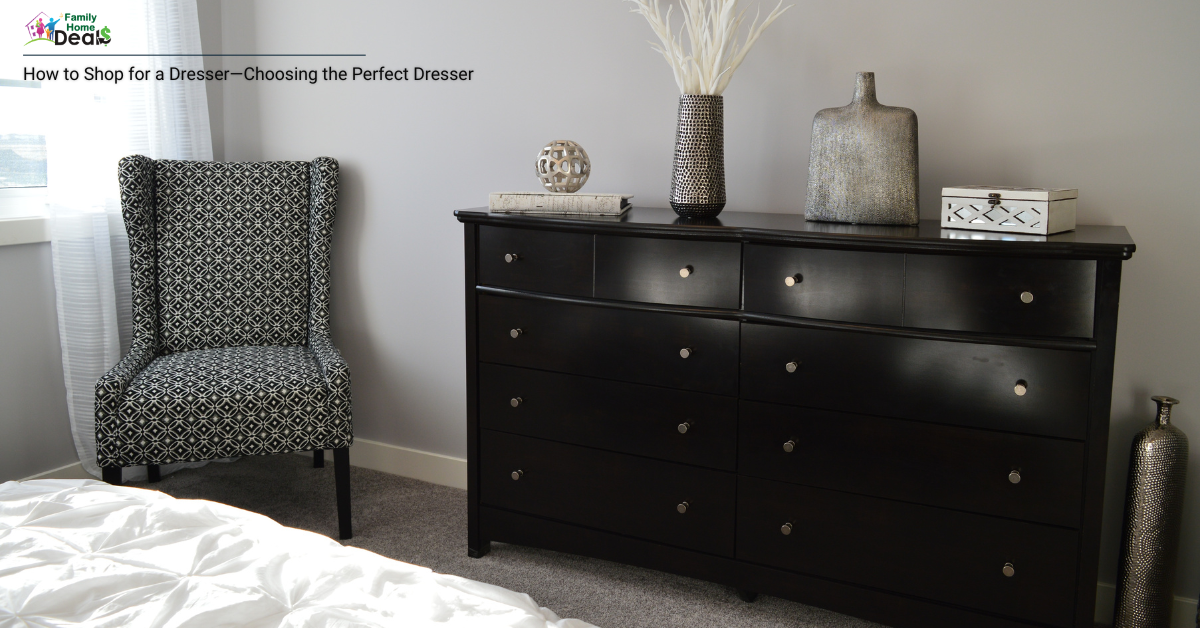
When it comes to outfitting your bedroom, a dresser isn’t just a storage solution—it’s a key element of your room’s design and functionality. Finding the right dresser can significantly enhance your space, offering both style and practicality. With numerous styles, materials, and features available, navigating the choices can be overwhelming. This comprehensive guide on how to shop for a dresser will help you make a well-informed decision that aligns with your needs, taste, and budget.
Whether you’re upgrading your existing furniture or selecting a dresser for a new home, understanding what to look for can make all the difference. We’ll explore every aspect of choosing the perfect dresser to ensure you end up with a piece that meets your requirements and enhances your bedroom.
How to Shop for a Dresser—Guide to Choosing the Perfect Dresser
1. Determine Your Needs
Before diving into the shopping process, it’s crucial to have a clear understanding of what you need from your dresser. This step will help you choose a piece that fits your specific requirements and enhances your bedroom’s functionality. Here’s a detailed approach to assessing your needs:
How Much Storage Space Do You Need?
Size of the Dresser:
- Assess Your Storage Requirements: Begin by evaluating how much clothing and other items you need to store. If you have an extensive wardrobe or additional items such as linens, books, or household supplies, you’ll need a dresser that offers ample storage.
- Types of Dressers:
- Large Dressers: These often feature a higher number of drawers and can include additional compartments or cabinets. Ideal for those with extensive clothing collections or multiple people sharing the dresser.
- Medium Dressers: A good choice for average-sized wardrobes and those looking for a balance between storage and space efficiency. They usually offer a moderate number of drawers and are suitable for most needs.
- Small Dressers: Perfect for smaller spaces or minimalist needs. They typically have fewer drawers and can serve as additional storage in rooms with limited space.
Drawer Sizes:
- Deep Drawers: Best suited for bulkier items such as sweaters, jeans, or blankets. They allow you to store larger items without needing to fold them too much, keeping your clothing more organized and accessible.
- Shallow Drawers: These are ideal for smaller items like accessories, undergarments, or folded t-shirts. Shallow drawers make it easier to find specific items quickly and can help in organizing smaller clothing pieces.
- Combination Drawers: Some dressers offer a mix of drawer sizes, combining deep and shallow drawers. This versatility is useful for storing a variety of items and keeping everything in its proper place.
What Items Will You Store?
Clothing vs. Other Items:
- Clothing Storage: If your primary need is for clothing, focus on the number and size of drawers to accommodate different types of garments. Consider whether you need dedicated space for folded clothes, hanging items, or even built-in hampers.
- Multi-Use Storage: If you plan to use the dresser for more than just clothes, such as storing linens, electronics, or household items, look for features that accommodate these needs. For example, dressers with extra shelves or larger compartments can provide additional storage space.
Special Needs:
- Jewelry and Accessories: If you have valuable jewelry or small accessories, consider a dresser with specialized compartments or a built-in jewelry organizer. Some dressers come with velvet-lined drawers or trays to keep these items secure and tangle-free.
- Important Documents: For storing documents, look for dressers with lockable drawers or secure compartments. This can be especially useful if you need to store sensitive information or valuables.
- Other Special Storage Needs: If you have unique items to store, such as craft supplies, electronics, or seasonal clothing, find a dresser with adjustable shelves or modular components that can be customized to fit these items.
What’s Your Bedroom Size?
Room Dimensions:
- Measure Your Space: Take precise measurements of the area where you plan to place the dresser. Measure the length, width, and height of the space to ensure the dresser fits comfortably. Also, consider the clearance around the dresser to allow easy access and movement.
- Placement Considerations: Make sure the dresser doesn’t obstruct any doors or windows and that it’s placed in a spot that doesn’t interfere with the room’s flow. Consider how the dresser will impact other furniture arrangements and room functionality.
Proportions:
- Balance in the Room: The size of the dresser should be proportional to the size of the room. A large dresser in a small room can overwhelm the space and make it feel cluttered. Conversely, a small dresser in a large room might seem out of place and insufficient for your storage needs.
- Visual Harmony: Aim for a dresser that complements the room’s overall design. For instance, a tall, narrow dresser may work well in a room with limited floor space, while a low, wide dresser might be better suited for a spacious room with a low ceiling.
2. Choose the Right Style
Dresser styles can range from classic to modern, and the right style will depend on your personal taste and existing bedroom decor. Here are some popular styles:
Traditional: Often features intricate carvings, elegant hardware, and classic wood finishes like cherry or mahogany. These dressers might have ornate legs and detailing.
- Best For: Traditional bedrooms with classic furniture and rich color schemes. It adds a touch of sophistication and timeless charm.
Modern: Characterized by clean lines, minimalistic design, and often high-gloss or matte finishes. These dressers may include sleek metal or glass accents.
- Best For: Contemporary spaces that emphasize simplicity and functionality. It suits rooms with a modern aesthetic and a neutral color palette.
Rustic: Emphasizes natural wood with a distressed or weathered look, often with metal accents or industrial elements. Features like exposed hardware and rough-hewn edges are common.
- Best For: Cozy, farmhouse-style rooms or those aiming for a warm, inviting atmosphere.
Industrial: Combines metal and wood with a utilitarian design. Often includes exposed bolts, metal framing, and reclaimed wood for a raw, edgy look.
- Best For: Urban or loft-style interiors that embrace a blend of modern and industrial elements. It adds a bold, contemporary touch.
3. Select the Right Material
The material of your dresser affects not only its durability but also its overall look and feel. Here’s a breakdown of the common materials:
Wood: Made from a single piece of wood, such as oak, maple, or walnut. It’s highly durable, can be refinished, and offers a natural, classic look. However, it’s usually more expensive.
- Advantages: Long-lasting, can be repaired or refinished, and often features unique grain patterns.
- Disadvantages: Can be heavy and pricey.
Wood Veneer: A thin layer of real wood applied over a less expensive base material. It gives the appearance of solid wood but at a lower cost.
- Advantages: More affordable than solid wood, looks similar to real wood.
- Disadvantages: Can be less durable and may peel or chip over time.
Laminate: Made from synthetic materials that imitate wood or other finishes. It’s typically used for budget-friendly options and is easy to clean.
- Advantages: Cost-effective, available in a variety of designs and colors.
- Disadvantages: Less durable, can look less authentic compared to real wood.
Metal: Often used in modern or industrial designs, metal dressers can include materials like steel or aluminum. They are durable and often have a sleek appearance.
- Advantages: Very sturdy, easy to clean, and often features a minimalist design.
- Disadvantages: May lack warmth and can be prone to scratches and dents.
4. Consider Functionality and Features
Additional features can significantly enhance the usability and convenience of your dresser. Here’s an in-depth look at various features that can improve your dresser’s functionality:
Adjustable Shelves
Functionality:
- Customization: Adjustable shelves allow you to modify the internal configuration of the dresser to fit items of different sizes. This flexibility is particularly useful for storing a range of items such as books, folded clothes, or linens.
- Versatility: Ideal for changing storage needs over time. If your storage requirements evolve, you can reposition the shelves to accommodate new items without having to buy a new dresser.
Considerations:
- Sturdiness: Ensure that the shelves are made from durable materials and have a strong support system. They should be able to hold the weight of the items you plan to store without sagging or bending.
- Ease of Adjustment: Look for a dresser with a user-friendly shelf adjustment mechanism. Shelves should be easy to reposition without requiring special tools or significant effort.
Built-in Mirrors
Functionality:
- Convenience: A built-in mirror provides a handy spot to check your appearance without needing to install a separate mirror elsewhere in the room. This feature is particularly useful for getting dressed or applying makeup.
- Spatial Perception: Mirrors can create a sense of depth and space, making a room appear larger and more open. This is especially beneficial in smaller or dimly lit rooms.
Considerations:
- Attachment: Verify that the mirror is securely attached to the dresser. It should be mounted in a way that prevents it from wobbling or detaching over time.
- Positioning: The mirror should be positioned at a height and angle that suits your needs. It should be comfortably within view when standing or sitting in front of the dresser.
Drawer Dividers
Functionality:
- Organization: Drawer dividers help keep small items organized and accessible. They are particularly useful for separating items such as socks, accessories, or office supplies, preventing them from getting tangled or lost.
- Flexibility: Many dividers are adjustable or removable, allowing you to customize the drawer layout based on your storage needs. This adaptability is useful if you need to reconfigure the drawer for different types of items.
Considerations:
- Adjustability: Look for dividers that can be easily adjusted or removed to accommodate different items. Fixed dividers may not offer the flexibility needed for various storage needs.
- Material: Ensure that the dividers are made from durable materials that can withstand daily use. They should be sturdy enough to stay in place and effectively organize your items.
Soft-Close Drawers
Functionality:
- Noise Reduction: Soft-close drawers prevent the slamming sound associated with traditional drawers. This feature enhances the overall user experience by providing a quieter and more pleasant operation.
- Durability: The soft-close mechanism reduces wear and tear on the drawer and its tracks, potentially extending the lifespan of your dresser. It also minimizes the risk of accidental injuries from slamming drawers.
Considerations:
- Mechanism: Check the soft-close mechanism for smooth operation. It should engage gently and close quietly without requiring excessive force.
- Durability: Ensure that the mechanism is built to last and can handle the weight of the drawer contents over time. Test the drawers to confirm that the soft-close feature functions consistently.
5. Measure and Fit
Proper measurements ensure that your dresser fits well in your space and functions as intended. Here’s a detailed guide to measuring:
- Height: Measure from the floor to the top of where you want the dresser to be placed. Ensure it doesn’t block windows or light sources.A dresser that’s too tall might overpower the room, while one that’s too short might not provide enough storage.
- Width: Measure the available wall space where you intend to place the dresser. Leave enough clearance on either side for ease of access. Ensure the width of the dresser complements other furniture and doesn’t obstruct room flow.
- Depth: Measure how far the dresser will extend into the room. Consider any obstacles, such as doors or radiators. A dresser that’s too deep might make the room feel cramped, while one that’s too shallow might not offer enough storage space.
6. Set Your Budget
Establishing a budget helps narrow down your choices and avoid overspending. Here’s a closer look at typical price ranges and what to expect:
- Budget-Friendly ($100 – $300): Typically made from laminate or lower-quality wood. Might include simpler designs and fewer features. It is best for smaller rooms or temporary solutions. Provides basic functionality without breaking the bank.
- Mid-Range ($300 – $600): Often made from better quality wood or wood veneer. May include additional features like adjustable shelves or soft-close drawers.
- Best For: Long-term investment with a balance of quality and affordability. Offers better design and durability.
- High-End ($600+): Premium materials such as solid wood or high-quality metal. Custom designs, fine craftsmanship, and additional features like built-in mirrors or specialized compartments.
- Best For: High-quality, stylish pieces that are built to last. Ideal for those seeking a luxurious and unique dresser.
7. Shop Smart
Maximize your shopping experience with these tips:
- Research Brands and Reviews: Look up customer reviews and ratings on retailer websites, forums, and review sites like Trustpilot or Yelp. Pay attention to feedback on durability, customer service, and the accuracy of product descriptions.
- Compare Prices: Check prices on multiple retailer websites and in-store. Don’t forget to look for sales or discounts.
- What to Consider: Factor in delivery and assembly costs when comparing prices.
- Check Return Policies: Ensure the retailer has a clear return or exchange policy in case the dresser doesn’t meet your expectations.
- Important Details: Note any restocking fees, return time limits, and conditions for returning furniture.
- Inspect the Dresser in Person: If shopping in-store, examine the dresser for any defects, check the finish, and test the drawer mechanisms.
- Additional Tips: Ask for samples of wood finishes or fabrics if you’re unsure about color or texture.
8. Consider Assembly and Delivery
Plan ahead for the practical aspects of getting your dresser into your home:
- Assembly:
- DIY vs. Professional: If you’re comfortable with tools, assembling the dresser yourself can save money. Otherwise, consider professional assembly services.
- What to Check: Ensure you have the necessary tools and instructions if assembling yourself. For professional services, confirm the cost and availability.
- Delivery:
- Options: Check if the retailer offers free delivery or if there are additional charges. Some retailers offer white-glove delivery, which includes setup and placement.
- Considerations: Ensure that the delivery team can navigate any obstacles in your home and place the dresser where you want it.
Find the perfect dresser for your home
Selecting the right dresser involves more than just picking a piece of furniture; it’s about choosing a functional and stylish addition that fits seamlessly into your bedroom. By carefully considering your needs, style preferences, and material options, you can find a dresser that enhances both the aesthetic and practical aspects of your space.
With this detailed guide on how to shop for a dresser, you’ll be equipped to make a choice that aligns with your requirements and budget. Whether you’re upgrading an old piece or buying new, remember to measure your space, compare options, and choose features that cater to your lifestyle.
Happy shopping! With these insights, you’re well on your way to finding the perfect dresser for your home.



